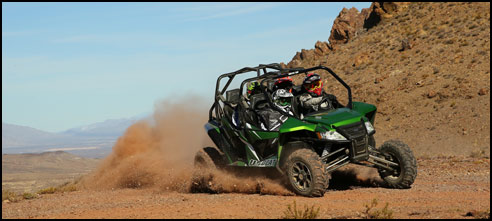|
The Wildcat wet cluch has been removed from the crankshaft (left) & the load size was reduced to lighten up weight on the Wildcat 4 1000 SxS / UTV |
The new Arctic Cat / Team Industries Rapid Response Clutch system in the 2013 Arctic Cat Wildcat 4 1000 SxS / UTV in addition to being lighter in weight, uses rolling elements in its design verse sliding elements in the previous models, thus creating less friction and improves efficiency. With the Team Industries Rapid Response Clutch system the Arctic Cat Wildcat 4 1000 SxS / UTV is able to maintain consistent RPMs no matter the terrain or load changes allowing instant power response throughout the RPM range.
 |
The new Team Industries Rapid Response Clutching system cured the lag that previous Arctic Cat Wildcat 1000 SxS / UTVs had. The power is instantaneous when you hit the gas pedal making the Arctic Cat Wildcat 4 a much more interesting & fun ride! |
|
The new Team Industries Rapid Response Clutch (left) is lighter & is more efficient than the standard Arctic Cat Wildcat 1000 SxS / UTV Clutch (right) |
With the new clutch assembly, the 2013 Arctic Cat Wildcat 4 1000 SxS / UTV has more responsive power in both high and low gear. Even fully loaded down with four passengers, the 2013 Arctic Cat Wildcat 4 1000 SxS / UTV has plenty of available power. We were able to reach an impressive 38 mph in low gear before the rev limiter kicked in. In high gear, we reached just under 60 mph, taking into the account the winding trail which limited our speed a bit. However, we felt that in wide-open sections the Wildcat 4 would be well capable of higher speeds.
 |
The 2013 Arctic Cat Wildcat 4 1000 SxS / UTV features an impressive 13 inches of ground clearance & long travel FOX podium shocks to make one plush ride |
Since its original release just over a year ago, the Arctic Cat Wildcat 1000 HO SxS / UTV has been known for its long travel suspension and 13 inches of clearance and this couldn’t be any truer for the all-new Arctic Cat Wildcat 4 1000 SxS / UTV.
|
Arctic Cat chose to use long travel FOX podium shocks instead of Walker Evans shocks & added a new light weight sway bar with less components |
For 2013, the Wildcat 4 features long travel FOX podium shocks that replaces the Walker Evans shocks that came standard on previous Wildcat SxS / UTV models. The FOX podium shocks have a 23 position compression adjustment, dual rate springs, remote piggyback reservoirs, that features 18 inches of travel in the rear and 17 inches of trail in the front. The Arctic Cat Wildcat 4 also has 13 inches of ground clearance, which was usable for navigating over large rocks on the trail. Arctic Cat also introduced a new rear sway bar designed to be paired with the new long travel FOX podium shocks that is lighter and features less components.
On our ride we encountered many deep whoop sections that really showed how well the suspension worked. Some whoops were 2 to 3 feet deep, but they were no match for the 2013 Arctic Cat Wildcat 4 1000 SxS / UTV. We were able to keep the machine pinned and skim right across the top of the deep whoops without and any bump steer or the rear end kicking out. This was due to a combination of the Wildcat 4 1000 SxS / UTVs long travel suspension and the 29 inch longer wheelbase that accommodates the rear seats.














